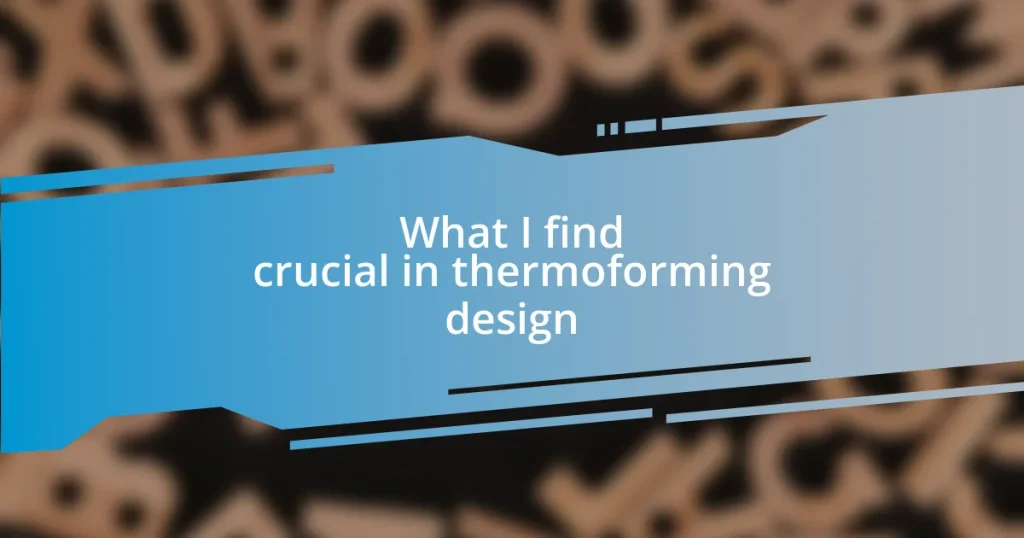Key takeaways:
- Understanding the critical role of material selection, including factors like temperature resistance and thickness, is essential for successful thermoforming outcomes.
- Maintaining wall thickness uniformity is vital for ensuring product strength, aesthetic consistency, and optimal heat distribution during the forming process.
- Utilizing advanced techniques like simulation software and just-in-time inventory can significantly enhance mold design efficiency and optimize production lead times.
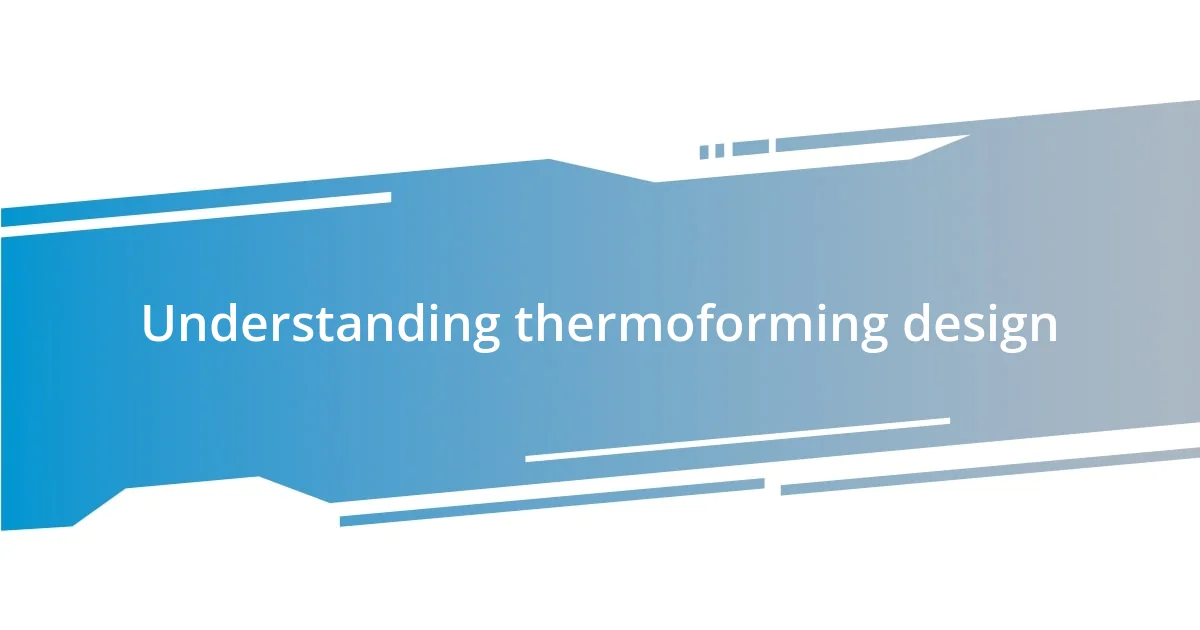
Understanding thermoforming design
Understanding thermoforming design involves grasping the fundamental principles that govern how heat and pressure interact with thermoplastic materials. I remember the first time I watched a thermoforming machine in action; the precision with which it shaped plastic was mesmerizing. It’s a delicate balance of temperature, material selection, and design that really makes the process fascinating.
At its core, thermoforming is about shaping materials with a perfect blend of science and artistry. Have you ever thought about how everyday products like packaging or automotive parts come to be? It’s through meticulous design that manufacturers can create functional yet aesthetically pleasing items. That attention to detail in the design phase is essential, as it can significantly affect the product’s performance and usability.
Every designer has their go-to strategies for optimizing thermoforming. I’ve learned that understanding the nuances of material behavior during the heating and cooling phases can completely transform the outcome. For instance, selecting the right gauge can enhance both structural integrity and visual appeal. It’s those kinds of insights that make the design process so critical and, frankly, exciting!
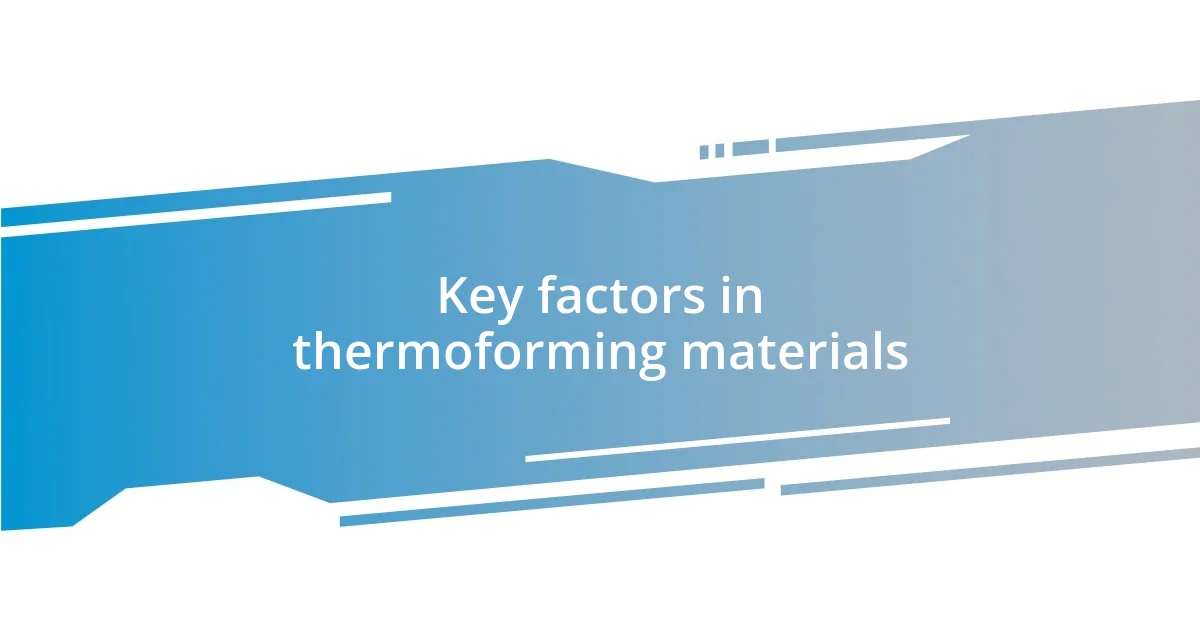
Key factors in thermoforming materials
The selection of materials for thermoforming is paramount to achieving optimal results. I vividly recall an experience where I opted for a less common plastic that, on paper, seemed perfect for a prototype. Unfortunately, it didn’t hold up during testing, and that was a learning moment for me; material properties can significantly impact not just aesthetics but also functionality.
When choosing materials, consider these key factors:
- Temperature Resistance: The material needs to withstand the heat used in the thermoforming process without warping.
- Draw Ratio: This indicates how much material can be stretched without tearing, affecting the finished product’s strength.
- Thickness: Proper gauge selection can make or break a project. Too thin, and you risk weakness; too thick, and you may have issues with heating.
- Surface Finish: The look and feel you want may require certain materials that provide better texture or clarity.
- Stability and Durability: The final product should meet the demands of its intended use, whether that’s for short-term packaging or long-term components.
Each factor plays a role in how the final product will perform, and it’s a blend of trial, error, and deep understanding that leads to successful outcomes in this field. When you find the right material, it’s like unlocking a door to endless possibilities!
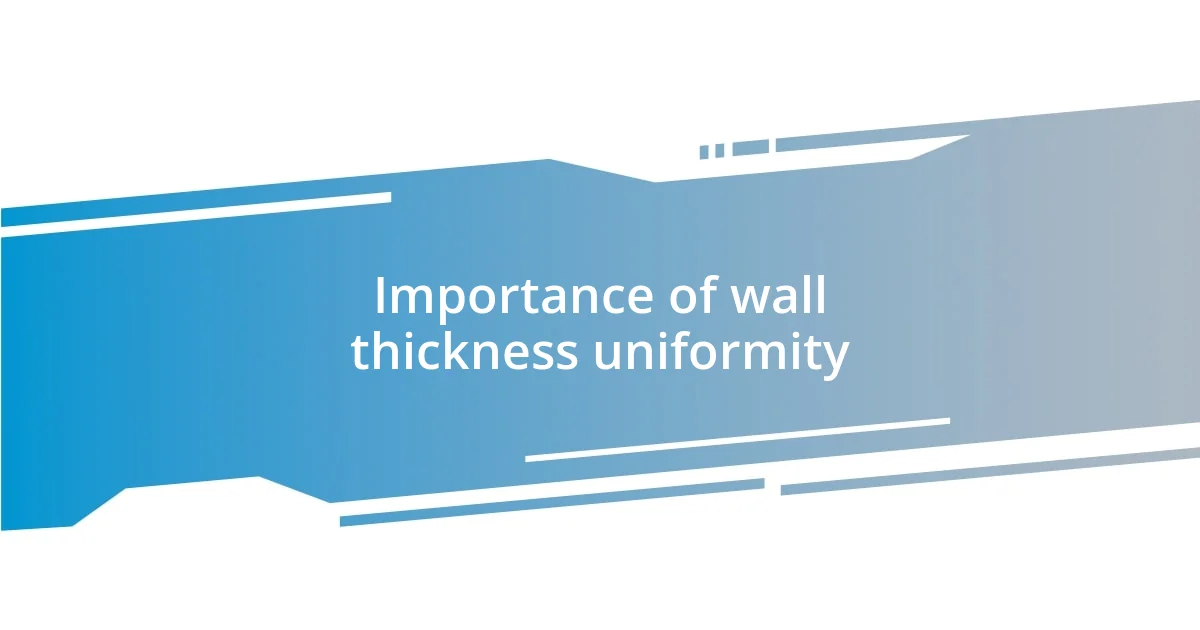
Importance of wall thickness uniformity
Wall thickness uniformity is critical in thermoforming because it directly impacts both the aesthetic and functional quality of the final product. When I was first getting into thermoforming, I remember seeing a batch where some parts were thicker than others. The inconsistency led to issues, such as warping and even cracking during use. That experience opened my eyes to how vital it is to maintain even wall thickness throughout a design; it not only ensures strength but also allows for a uniform appearance.
Additionally, wall thickness uniformity is essential for the material to heat evenly. I’ve had projects where I thought a slight variation in thickness wouldn’t matter much, but the results were eye-opening. The thicker sections took longer to heat up, leading to imperfect forming. This taught me that even small discrepancies could bring about significant challenges during the thermoforming process; it’s all about aligning heat distribution with the design’s requirements.
To glue these ideas together, manufacturers prioritize wall thickness uniformity not just for performance, but for reliability. Think about it: How frustrating is it when you receive a product that isn’t up to par because of something seemingly minor? In my experience, the most successful thermoformings are those where attention to wall thickness is unwavering. This principle allows for predictability, which ultimately supports better product quality and, therefore, customer satisfaction.
| Key Aspects | Significance |
|---|---|
| Structural Integrity | Maintains product strength and durability. |
| Heat Distribution | Ensures even heating for optimal forming. |
| Aesthetic Consistency | Provides a visually appealing uniform surface. |
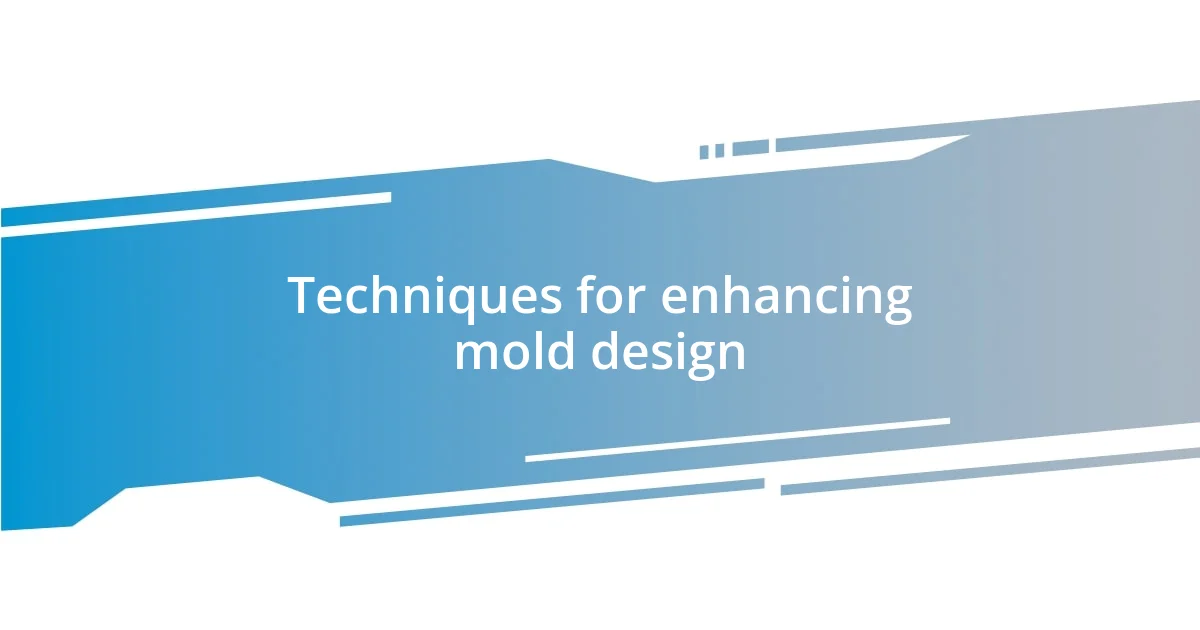
Techniques for enhancing mold design
When it comes to enhancing mold design for thermoforming, incorporating advanced software for simulation can be a game changer. I remember a project where I faced challenges with mold filling and cooling times. By utilizing simulation software, I was able to visualize how the material would flow into the mold. It’s fascinating to see how digital tools can predict potential issues before they arise, allowing for adjustments that save time and resources. Have you ever thought about the impact of visualizing the process? It can really shift your approach to mold design.
Another effective technique is the implementation of cooling channels within the mold. This might sound technical, but trust me, it can significantly affect production efficiency. In one of my earlier projects, I neglected this aspect, resulting in longer cycle times and increased production costs. Once I integrated strategically placed cooling channels, the improvement was remarkable. The molds not only cooled faster, but I also achieved greater consistency in the final product’s quality. It serves as a reminder that sometimes, the most straightforward adjustments can yield the best results.
Lastly, I’ve found that using a modular mold design can greatly enhance flexibility. When I first experimented with this, I was able to swap out different components of the mold to test various designs without starting from scratch. It saved me both time and materials while allowing for rapid prototyping. Do you see the value in such adaptability? I certainly do, as it fosters innovation and encourages experimentation, which are vital in the ever-evolving field of thermoforming.
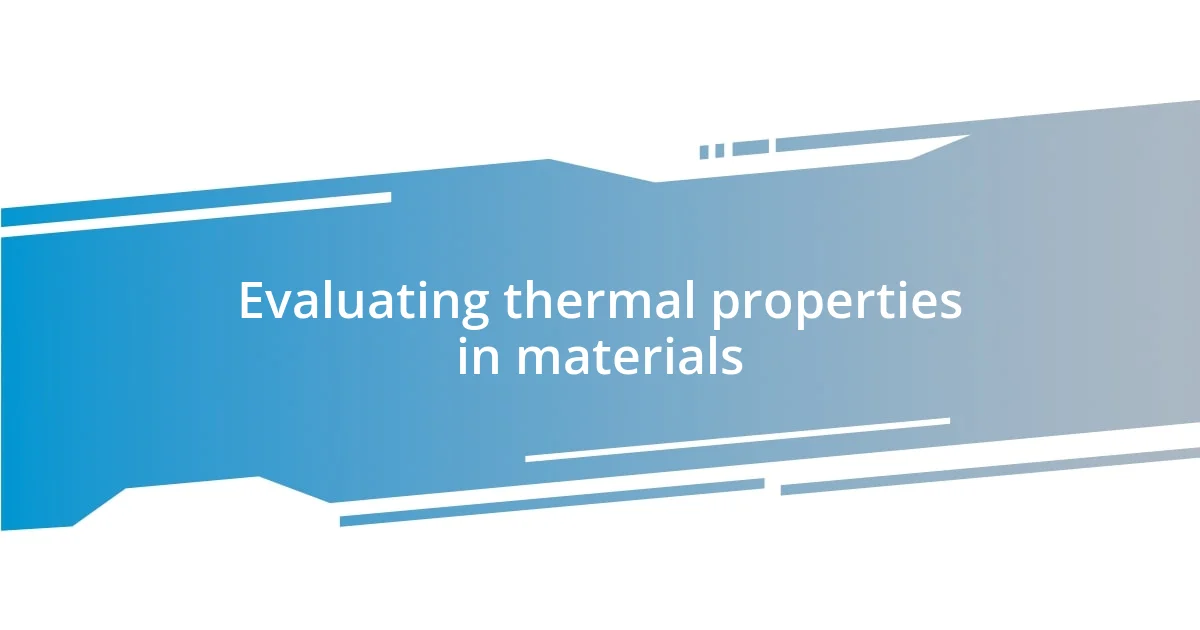
Evaluating thermal properties in materials
Evaluating the thermal properties of materials is essential to ensure they perform well during the thermoforming process. I’ve had experiences where I assumed a certain plastic would behave predictably under heat, only to discover that its thermal conductivity was off. That realization pushed me to pay much closer attention to a material’s thermal characteristics, understanding how they affect not just the forming process but also the final product’s integrity.
One key takeaway is knowing the difference between thermal expansion and thermal conductivity. Thermal expansion refers to how much a material expands when heated, while thermal conductivity measures how effectively heat moves through it. In one project, I overlooked the thermal expansion of a specific grade of polycarbonate. During forming, the material expanded unevenly, which led to warping that was both frustrating and costly. It really drove home the idea that knowing these distinctions can make all the difference in achieving the desired outcome.
Let’s not forget about the importance of temperature ranges in material performance. For instance, I remember working with a thermoplastic that had a surprisingly low heat tolerance. Despite its appealing aesthetic properties, the final product ended up losing structural integrity when subjected to higher temperatures. This experience reinforced my belief that understanding the thermal limits of materials isn’t just a technical aspect; it’s crucial for avoiding potential failures down the line. How can we expect a product to perform under pressure when we don’t fully grasp its capabilities?
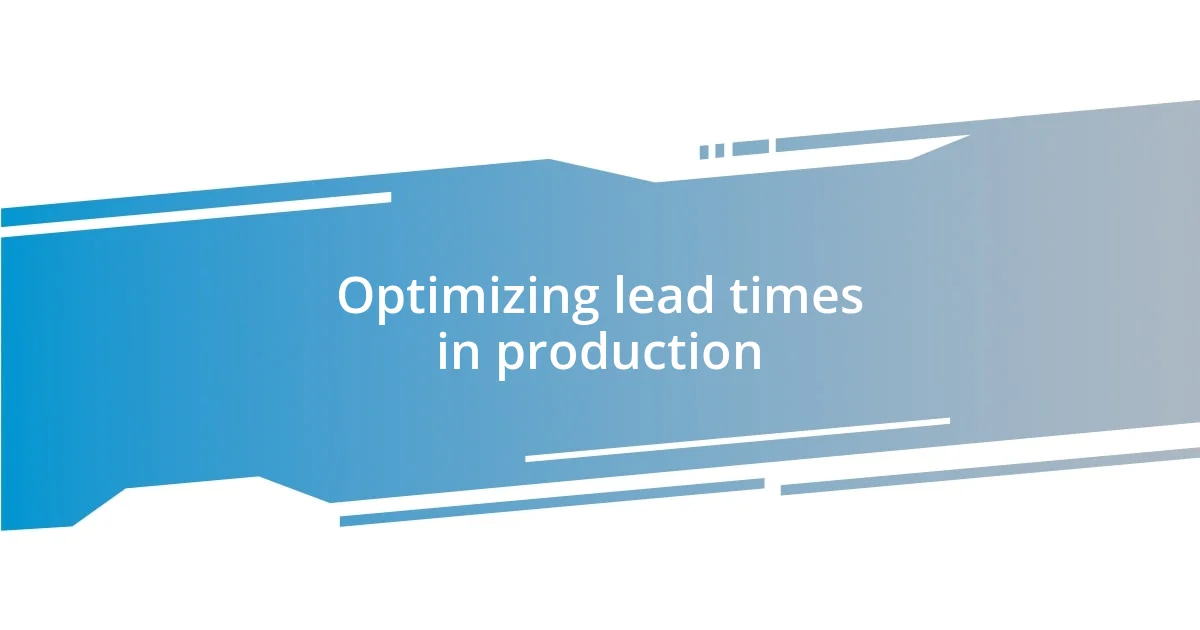
Optimizing lead times in production
Optimizing lead times in production often hinges on meticulous planning and effective communication within the team. I’ve learned that establishing clear timelines early in the project helps set realistic expectations. During one major project, we fell behind because assumptions about lead times were not addressed upfront. I can’t stress enough how that experience taught me the importance of aligning everyone’s understanding and being transparent about potential delays. Have you faced similar challenges in your work?
Another factor I find crucial is leveraging just-in-time (JIT) inventory strategies. In my experience, reducing excess inventory not only cuts costs but also keeps the production flow more adaptable. For example, by ensuring we only ordered materials as needed, I noticed a dramatic reduction in lead times. It’s incredible what a bit of strategic timing can do—have you ever tried implementing JIT in your processes? It can really streamline operations.
Lastly, I believe in the power of automation to enhance efficiency in production. When we integrated automated systems for tracking orders and managing workflow, it felt like a weight had been lifted off my shoulders. I recall a time when manual processes led to missed deadlines and confusion; transitioning to automation made such a difference. It’s clear that embracing technology can lead to shorter lead times and better overall productivity. Why not explore the transformative potential of these tools to see how they could benefit you?











